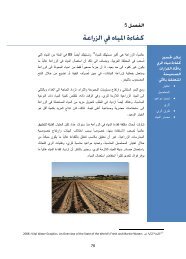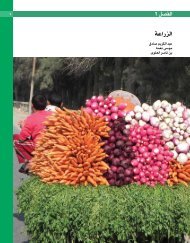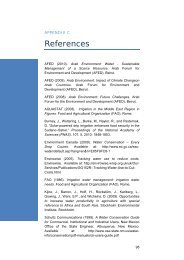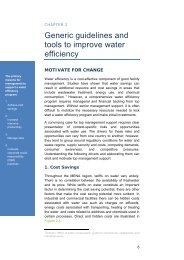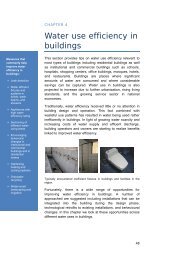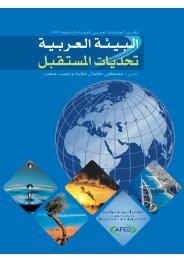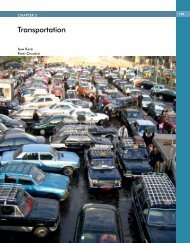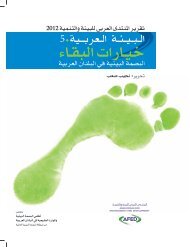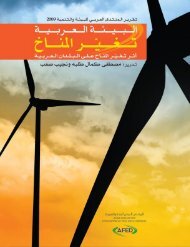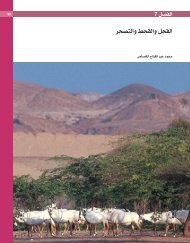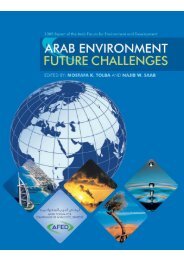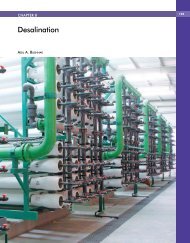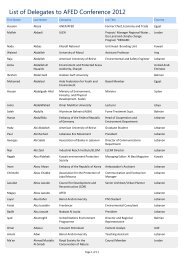Impact of Climate Change on Arab Countries - (IPCC) - Working ...
Impact of Climate Change on Arab Countries - (IPCC) - Working ...
Impact of Climate Change on Arab Countries - (IPCC) - Working ...
You also want an ePaper? Increase the reach of your titles
YUMPU automatically turns print PDFs into web optimized ePapers that Google loves.
66<br />
CHAPTER 5<br />
FOOD PRODUCTION<br />
The water situati<strong>on</strong> in the <strong>Arab</strong> regi<strong>on</strong> is threatened<br />
by both envir<strong>on</strong>mental and socio-ec<strong>on</strong>omic<br />
pressures. Many negative impacts <str<strong>on</strong>g>of</str<strong>on</strong>g> climate<br />
change <strong>on</strong> freshwater systems are observed in<br />
recent studies. These impacts are mainly due to<br />
the observed and projected increases in temperature,<br />
evaporati<strong>on</strong>, sea level and precipitati<strong>on</strong> variability<br />
(<strong>IPCC</strong>, 2007a). Decreases in precipitati<strong>on</strong><br />
are predicted by more than 90% <str<strong>on</strong>g>of</str<strong>on</strong>g> climate<br />
model simulati<strong>on</strong>s by the end <str<strong>on</strong>g>of</str<strong>on</strong>g> the 21st century<br />
for the North Africa and Middle East regi<strong>on</strong><br />
(<strong>IPCC</strong>, 2007b).<br />
<str<strong>on</strong>g>Change</str<strong>on</strong>g>s in annual mean run<str<strong>on</strong>g>of</str<strong>on</strong>g>f are indicative <str<strong>on</strong>g>of</str<strong>on</strong>g><br />
the mean water availability for vegetati<strong>on</strong>.<br />
Projected changes between now and 2100 show<br />
some c<strong>on</strong>sistent run<str<strong>on</strong>g>of</str<strong>on</strong>g>f patterns: increases in high<br />
latitudes and the wet tropics, and decreases in<br />
mid-latitudes and some parts <str<strong>on</strong>g>of</str<strong>on</strong>g> the dry tropics.<br />
Declines in water availability are therefore projected<br />
to affect some <str<strong>on</strong>g>of</str<strong>on</strong>g> the areas currently suitable<br />
for rain-fed crops (e.g., in the Mediterranean<br />
basin and sub-tropical regi<strong>on</strong>s) (Christensen et<br />
al., 2007).<br />
<str<strong>on</strong>g>Climate</str<strong>on</strong>g> change will increase c<strong>on</strong>sumptive water<br />
use in key sectors in the future, especially in<br />
countries that have limited water resources, high<br />
populati<strong>on</strong> growth and high development rates<br />
(Medany, 2007). Magano et al. (2007) point out<br />
that irrigati<strong>on</strong> demands will increase and the irrigati<strong>on</strong><br />
period <str<strong>on</strong>g>of</str<strong>on</strong>g> supplementary irrigati<strong>on</strong> will<br />
become l<strong>on</strong>ger under projected climate changes.<br />
For example, the total annual reference irrigati<strong>on</strong><br />
demands <str<strong>on</strong>g>of</str<strong>on</strong>g> Egypt are projected to increase by 6<br />
to 16% by the 2100s, due to the increase in reference<br />
evapotranspirati<strong>on</strong> values, which will lead<br />
to a general increase in the crop-water demands.<br />
Figure 1 illustrates the change in crop-water<br />
requirements <str<strong>on</strong>g>of</str<strong>on</strong>g> major field and vegetable crops<br />
due to the change in temperature and CO 2 levels<br />
based <strong>on</strong> the <strong>IPCC</strong> SRES A1 and B1 scenarios<br />
for the 2025s, 2050s and 2100s (Medany, 2008).<br />
Smallholder agriculture is used here to describe<br />
rural producers, who farm using mainly family<br />
labour and for whom the farm provides the<br />
principal source <str<strong>on</strong>g>of</str<strong>on</strong>g> income (Cornish, 1998).<br />
Pastoralists and people dependent <strong>on</strong> artisanal<br />
fisheries and household aquaculture enterprises<br />
(Allis<strong>on</strong> and Ellis, 2001) are also included in this<br />
category. Smallholders in most <str<strong>on</strong>g>of</str<strong>on</strong>g> the <strong>Arab</strong><br />
countries are poor and suffer in varying degrees<br />
from problems associated both with subsistence<br />
producti<strong>on</strong> (isolated and marginal locati<strong>on</strong>,<br />
small farm size, informal land tenure and low<br />
levels <str<strong>on</strong>g>of</str<strong>on</strong>g> technology), and with uneven and<br />
unpredictable exposure to world markets, which<br />
FIGURE 1<br />
CHANGE BETWEEN CURRENT AND FUTURE VALUES (FOR YEARS 2025S, 2050S AND 2100S) AT NATION-<br />
AL LEVEL SEASONAL CROP-WATER REQUIREMENTS OF SOME FIELD AND VEGETABLE MAJOR CROPS<br />
16<br />
Crop-water requirement change (%)<br />
14<br />
12<br />
10<br />
8<br />
6<br />
4<br />
2<br />
0<br />
2025 2050 2100 2025 2050 2100<br />
Wheat [W] Tom ato [N] Potato [S] Maize [N] Potato [W]<br />
M aize [S]<br />
A1<br />
Tom ato [W ] Broad Bean [W ] Tom ato [S] Potato [N]<br />
Source: Medany, 2008 W: Winter seas<strong>on</strong> S: Summer seas<strong>on</strong> N: Nili seas<strong>on</strong><br />
B1



